You're using an outdated browser. Please upgrade to a modern browser for the best experience.
Please note this is an old version of this entry, which may differ significantly from the current revision.
Subjects:
Chemistry, Physical
The São Francisco craton and its continuation in Africa, the Congo Craton [5], constitute Archean–Paleoproterozoic paleocontinents which, via various continental collisions during the Neoproterozoic–Cambrian, formed the western portion of the Gondwana supercontinent. The folded Brasiliano/Pan African belts occur on the margins of the paleocontinents in the form of several superimposed sedimentary basins, showing different types of magmatic arcs (accretionary material) and which, via collisional processes, were transformed into Neoproterozoic–Cambrian orogenic belts.
- neoproterozoic orogens
- São Francisco craton (SFC)
- neoproterozoic sedimentary basins
- diachronic orogenic evolution
- Brazil
1. Introduction
The São Francisco craton is surrounded by several orogenic belts, most notably the Brasília belt (to the west), the Rio Preto, Riacho do Pontal, and Sergipano belts (to the north), and the Araçuaí belt, which grades into the Ribeira belt (to the southeast; Figure 1). The boundaries between the São Francisco craton and the Neoproterozoic belts are generally transitional, indicated by increased orogenic deformation, with folds and thrust faults or nappes. The boundary is usually indicated by the first reverse fault affecting the cover and basement rocks [1,3,7,8].
The São Francisco craton comprises two stratigraphic units: 1—an Archean–Paleoproterozoic basement (gneisses, granitoids, greenstone belts, and supracrustal rocks older than 1.8 Ga) and 2—Sedimentary Proterozoic–Phanerozoic stratigraphic units, generally little deformed to horizontal [2,3,7,8].
The Neoproterozoic orogenic belts are made up of several superimposed, strongly deformed (thrust–fold belts) and metamorphosed stratigraphic units, ranging from greenschist to granulite facies. The stratigraphic units represent (1) Tonian and Cryogenian, rift to passive margin sedimentary basins, with slivers of ophiolitic rocks; (2) accretionary material (pre-collisional granitoids from intraoceanic and continental magmatic arcs); (3) sedimentary sequences derived from magmatic arcs; (4) syn- to post-collisional granitoids; and (5) tectonic occurrences of Archean–Paleoproterozoic basement (microcontinents) [4,7,8,9].
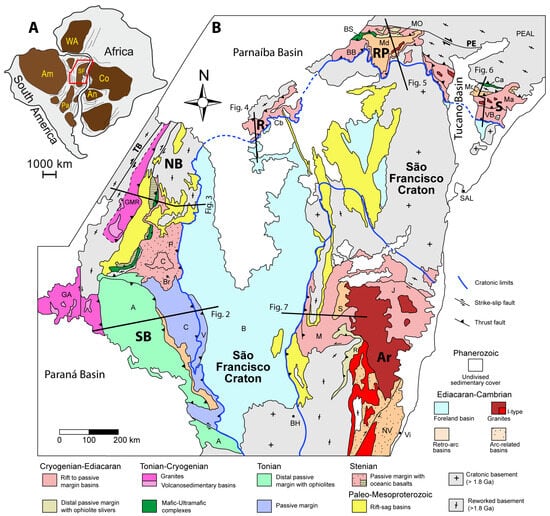
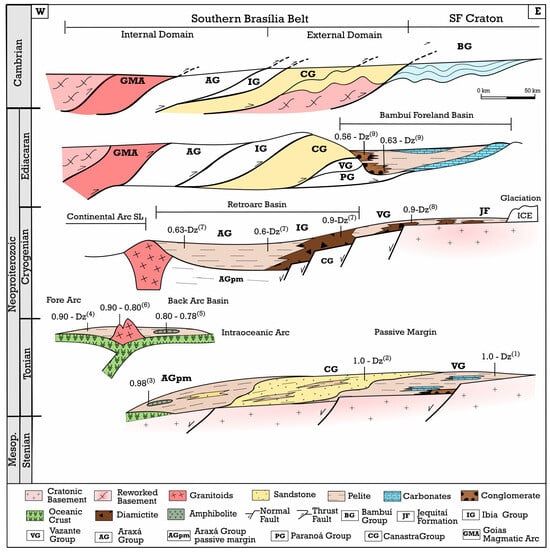
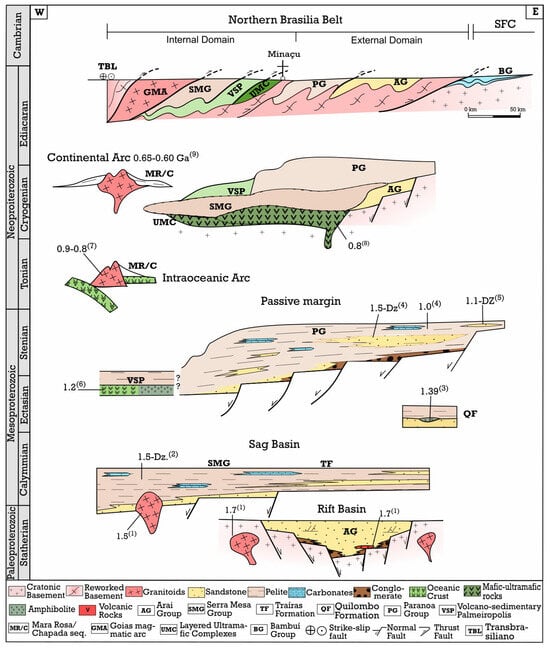
2. Southern Brasília Orogen
The Neoproterozoic fold–thrust Brasília orogen [1,13,14,15] is one of the main tectonic units in Central Brazil, a well-preserved Neoproterozoic orogenic belt within the Tocantins Province (Figure 1). The Brasília Belt can be subdivided into the northern and southern belts, which show important stratigraphic, tectonic, and geochronological differences [13,14,15,16]. In this paper, we will discuss the Brasília Belt as two independent orogens, where the Southern Brasília Belt was produced by the collision between the Paranapanema and São Francisco cratons, and the Northern Brasília Belt was produced by the collision between Amazonian and São Francisco cratons [15,17]. The southern Brasília orogen shows a tectonic interference zone with the Ribeira belt in the Socorro-Guaxupé nappe region [18,19] and extends northwest, making a bend and inflecting toward an E-W trend south of the Pirineus syntax [20].
The Southern Brasília orogen presents two structural domains: (1) an internal domain, with allochthon units (the upper nappe complex), prominent subhorizontal schistosity, and medium to high degree of metamorphism; and (2) an external domain, a typical fold–thrust belt, with subhorizontal foliation and an overall low degree of metamorphism (greenschist). Beyond the Brasília Belt, to the east, the cratonic domain occurs, characterized by the Ediacaran–Cambrian sedimentary cover of the Bambuí Group, with two subdomains: (1) a thin-skinned foreland fold–thrust belt; and (2) a central domain with subhorizontal layers [3]. The Southern Brasília Belt shows a predominance of Neoproterozoic passive margin units, with ophiolitic slivers, magmatic arcs, and syn-orogenic basins, now exposed along a fold–thrust system [14,15,18]. The passive margin of the Southern Brasília belt (Figure 2) is formed by the Vazante Group (lower unit—eastward), Canastra Group (middle unit), and Araxá Group (upper unit—westward).

Figure 1. (A): The Western Gondwana supercontinent with Neoproterozoic orogens and cratons and location of (B). (B): The São Francisco craton and Neoproterozoic fold belts. Modified from [9]. The locations of the geologic sections from Figures 2–7 are indicated by black lines. Fold belts: SB—Southern Brasília; NB—Northern Brasília; R—Rio Preto; RP—Riacho do Pontal; S—Sergipano; Ar—Araçuaí. Stratigraphic units from the Southern Brasília fold belt: A: Araxá Group; C: Canastra Group; GA: Goiás/Arenópolis Magmatic Arc; I: Ibiá Group; V: Vazante Group. Stratigraphic units from the Northern Brasília fold belt: GMR: Goiás/Mara Rosa Magmatic Arc; P: Paranoá Group. Stratigraphic units from the Rio Preto fold belt: Cb: Canabravinha Formation. Stratigraphic units from the Riacho do Pontal fold belt: BB: Barra Bonita Formation; BS: Brejo Seco Complex; M: Mandacaru Formation, MO: Monte Orebe ophiolite. Domains from the Sergipano fold belt: C: Canindé Domain; Ma: Macururé Domain; Mr: Marancó Domain; PEAL: Maciço Pernambuco-Alagoas; VB: Vaza Barris Domain. Stratigraphic units from the Araçuaí fold belt: M: Macaúbas Group; J: Jequitinhonha Complex; NV: Nova Venécia Complex; R: Ribeirão da Folha Formation; S: Salinas Formation. Lineaments: PE: Pernambuco lineament; TB: TransBrasiliano lineament. Cities: BH—Belo Horizonte; Br—Brasília; SAL—Salvador; Vi—Vitória.

Figure 2. The Southern Brasília belt: sedimentary basins, extensional and contractional events, and geological evolution [14,15,17]. Geochronological data: 1—[21,22]; 2—[27,29]; 3—[38]; 4—[50]; 5—[33,35,38]; 6—[46,47,48]; 7—[28,36,37,43]; 8—[24]; 9—[53]. Dz: Detrital zircon.
The Vazante Group (250 km long and 25 km wide) occurs between the cratonic domain (Bambuí Group) on the east and the Southern Brasília external domain (Canastra-Ibiá thrust) on the west. It is composed of metapelites and stromatolite-bearing meta-dolomites [14] with a controverse age of sedimentation, either Stenian or, more probably, Tonian [21]. Hf data of detrital zircon indicate that sources were represented mainly by recycled Paleo-Mesoproterozoic crust of the São Francisco paleocontinent, suggesting a passive margin context [22]. Recently, Marques et al. [23,24] correlated conglomerates (diamictites) and pelites of the base of the Vazante Group to the Jequitaí Formation (Bambuí Group). The Paranoá Group outcrops locally, below the Bambuí Group, in the cratonic domain, near reverse faults [14,25,26].
The Canastra Group consists mainly of metasandstones, metapelites, and subordinate metacarbonate lenses, with a thickness of 3500–4500 m. In the Paracatu region (northwestern state of Minas Gerais), the Canastra Group represents a sedimentary regressive megacycle [14]. The lower part, consisting of metapelites rich in organic matter and pyrite, represents deep-water sediments, overlain by turbiditic metarythmites and quartzites with hummocky structures, suggesting offshore platform sediments. The youngest detrital zircons, dated at ca. 1.0 Ga, suggest a Neoproterozoic sedimentation age and a cratonic (SF Craton) provenance for this group [27,28,29].
The Araxá Group comprises metapelitic schists (with biotite and garnet) and paragneisses (with feldspar, quartz, and biotite), chlorite schists and amphibolites, quartzites, metabasic schists, and metaultramafic lenses, with amphibolite metamorphic grade [14]. Rock associations of oceanic affinity are present, with graphitic schists, calc-silicate rocks, and minor iron and manganese formations and metachert [27,30,31]. The Araxá Group shows turbiditic metarhythmites and lenticular quartzites, suggesting submarine fan sedimentation in the passive margin basin. The Araxá Group schists and paragneisses frequently contain lenses and pods of metabasic (chlorite schists and amphibolites) and metaultrabasic rocks (small lenses of serpentinite, amphibolite, and talc schist, with podiform chromite deposits) representing a long, roughly N-S trending ophiolitic mélange [32,33,34]. Amphibolites intercalated with the Araxá schists near the city of Goiânia have been dated at ca. 800 Ma (SHRIMP U-Pb zircon data [35]). The Araxá metasedimentary rocks present a bimodal pattern of Sm–Nd model ages, suggesting different source areas, one of which is related to the Neoproterozoic Goiás Magmatic Arc [36]. The interpretation has been corroborated by U-Pb age patterns of detrital zircon grains, which display an abundant Neoproterozoic population, with ages between ca. 900 (paleocontinent provenance) and 630 Ma (magmatic arc provenance) [15,36,37].
The Anápolis–Itauçú Complex outcrops in a NW–SE elongated zone exposed between the Goiás Magmatic Arc and Araxá Group, southern Goiás state. The Complex consists of ortho- and paragranulites, with layered mafic–ultramafic rocks, locally presenting ultra-high-T mineral assemblages [16,39,40,41,42]. Geochronological data support the interpretation that at least part of the Anápolis–Itauçú Complex may represent high-grade equivalents of the Araxá Group in the metamorphic core of the Southern Brasília belt [16,41,42].
The Ibiá Group is composed of two units: the basal Cubatão Formation (metadiamictites with clasts of granite–gneiss, quartzites, schists or phyllites, and carbonate rocks) and the upper Rio Verde Formation (phyllites, metarythmites, and quartzites). The basal-diamictites have the youngest dated zircons at 935 ± 11 [28,29]. The upper Rio Verde Formation has the youngest grains dated at 636 ± 21 Ma [28], at 639 ± 15 [43], and at 580 Ma [37]. The Cubatão Formation in the Brasília Belt is correlated to the glacial Jequitaí Formation on the easterward São Francisco paleocontinent, featuring a transition between subaqueous gravitational sedimentation (debris flow) and marine glacial sedimentation to the east [7,24]. A regional glaciation (Marinoan glacial event [44]) developed in the São Francisco paleocontinent in the Cryogenian/Ediacaran transition (630 Ma), related to the glaciomarine sedimentation of the Jequitaí Formation. This unit also outcrops into the Brasília belt in the Cristalina dome (south of Goiás State). The Rio Verde Formation is interpreted as representing syn-orogenic sedimentation derived from the continental magmatic arc in a retroarc foreland basin [31,37,45].
The Goiás Magmatic Arc is one of the most important tectonic units of the Brasília Belt (Figure 2). The southern sector of the Goiás Magmatic arc is known as the Arenópolis arc [46,47,48]. Early evolution of the arc took place in Tonian intra-oceanic island arcs between ca. 930 and 810 Ma, with the crystallization of very primitive tholeiitic to calc-alkaline volcanics and associated tonalites/granodiorites [47,48,49]. The rocks display positive εNd(t) values and the Nd TDM model ages mostly between 0.8 and 1.1 Ga [46,47]. The intra-oceanic Arenópolis Island Arc was the first subduction-related orogen recorded by the accretion of juvenile calc-alcaline metatonalite bodies. It records a long-lived (250 Ma) plate convergence motion in a large oceanic basin. A younger cycle of magmatic activity took place between ca. 670 and 600 Ma [16,48,49]. This second cycle also comprises volcanic–sedimentary sequences, calc-alkaline tonalite–granodiorite intrusions, as well as bi-modal intrusions comprised of gabbro/diorite/granite. Sm-Nd data produced TDM values varying in a much wider range, from ca. 0.9 to 2.2 Ga, suggesting a higher contribution/contamination with older continental crust and indicating that this second event took place in a continental arc. Supracrustal volcano–sedimentary sequences of the Goiás Magmatic arc comprising calc-alkaline metavolcanic rocks, feldspar-bearing mica schist, and minor quartzites (e.g., the Arenópolis and Bom Jardim de Goiás sequences).
A westward-dipping subduction zone is proposed to produce an intra-oceanic arc during the Tonian, with consumption of the small oceanic basin formed between the island arc and the paleocontinent (back-arc basin) (Figure 2). During the Tonian–Cryogenian, the island arc remnants were docked to the passive continental margin of the São Francisco paleocontinent [47,49]. As a result, subduction polarity reversal probably occurred, with the development of the Goiás continental arc (Arenópolis arc) in the Cryogenian–Ediacaran, by partial melting of the coupled continental margin and juvenile arc set at 670–600 Ma (Figure 2) [49].
In summary, the Southern Brasília orogen shows several overlapping sedimentary basins (Figure 2): (1) a Tonian passive margin (Araxá, Canastra, and Vazante Groups); (2) a Tonian fore and back intra-oceanic arc basins [33,38,50]; (3) a Cryogenian–Ediacaran retroarc foreland basin constituted by the Ibiá Group, part of the Araxá Group and Santo Antonio–Rocinha Formations (Vazante Group), with the lateral transition to the São Francisco paleocontinent [24,31,43,45].
3. The Northern Brasília Orogen
The southern limit of the Northern Brasília belt is the Pirineus syntaxis, where the structures are E-W oriented, verging south and gradually forming an arc to the north, which verges eastward to the São Francisco craton. The external zone of the Northern Brasília belt is a fold–thrust belt of low-grade paleo-mesoproterozoic metasedimentary rocks. The internal zone comprises syn-orogenic volcano–sedimentary sequences and calc-alkaline plutonic rocks related to the Goiás Magmatic Arc, the Goiás massif (a probably exotic Archean–Paleoproterozoic continental fragment), Neoproterozoic layered complexes, and Mesoproterozoic (Ectasian–Stenian) volcano–sedimentary sequences. (Figure 3). Neoproterozoic units in the Northern Brasília Belt occur locally and correspond to the magmatic arc of Mara Rosa and to the Mafic–Ultramafic Complexes [1,14,16,49,63,64].
In the Northern Brasília belt, Paleo-mesoproterozoic rocks predominate, overlapping different sedimentary basins. The Statherian Araí Rift is noteworthy, consisting of the Arraias Formation with thick alluvial quartzites and conglomerates deposited in a rift phase, with mechanical subsidence and intercalations of metavolcanic rocks (basalts, riolythes, agglomerates). An important first extensional phase, with the development of normal faults, must have occurred, associated with the Arraias Formation and A-type granitoids and acid-intermediate volcanic rocks [14,65,66]. The Calymmian Traíras Group represents an intracontinental sag-type basin separated from the Arraias rift basin by an unconformity [67]. The Traíras Group shows fine-grained quartzites, pelites, and lenses of limestones and dolomites [14]. The Serra da Mesa Group (1000–3000 m thick) corresponds to a succession of coarse quartzites (base) and fine-grained, laminated, muscovite-rich quartzites. In the upper part, mica schists mainly occur with minor quartzites and stromatolite-bearing marbles deposited in a marine shelf setting [14]. During the Calymmian, there was a transition from the Traíras Group to the Serra da Mesa Group in the same sag basin [66,67].
During the Ectasian–Stenian, another basin develops that is strongly asymmetrical, associated with an important extensional phase, filled by the sediments of the Paranoá Group. It consists of sandstones, pelites, rhythmites, and carbonate lenses with columnar stromatolites arranged in transgressive and regressive cycles [14,69,70]. The São Miguel conglomerate (basal) indicates an erosive unconformity between the Paranoá Group and the older Proterozoic basins. Available geochronological data for the Paranoá Group consists of detrital zircon U-Pb ages determining a maximum depositional age of 1560 ± 10 Ma and a diagenetic xenotime U-Pb age suggesting deposition at 1042 ± 22 Ma [71]. The 50 m thick São Miguel conglomerate represents the rift phase of the Paranoá basin [49,72]. It is overlain by marine rhythmites and sandstones deposited in a shelf environment dominated by tidal and storm currents [14,70]. The sediments in the upper portion of the Paranoá Group display features indicating more varied environments, reflecting important sea-level fluctuations: deeper water pelites alternate with rhythmites and quartzites, storm-influenced rhythmites, limestones, and stromatolitic dolomites [70].
Three Meso-Neoproterozoic mafic–ultramafic layered complexes define a 350 km belt striking NNE-SSW along the central–northern part of the Northern Brasília Belt. The composite intrusions are known as the Canabrava, Niquelândia, and Barro Alto complexes, from north to south, e.g., [47,75,76,77]. The western part of the belt comprises sedimentary and volcanic rocks of the Juscelândia, Indaianópolis, and Palmeirópolis sequences and gabbro–anorthosite complexes of the Serra da Malacacheta and Serra dos Borges, formed in a rift environment that evolved to the ocean floor at ca. 1270 Ma. The volcano–sedimentary sequences of Palmeirópolis, Juscelândia, and Indaianópolis are made of bimodal metavolcanic rocks, metabasalt, metachert, and mica schists. The metabasalts have a MORB affinity, a U-Pb age of 1.2 Ga, and an extensional rifting context [47,49,75,77,78] and are probably the oceanic crust of the Paranoá passive margin (Figure 3).
The Barro Alto, Niquelândia, and Canabrava mafic–ultramafic layered complexes (UMC) show a lower mafic zone (gabbro–norite), ultramafic zone (dunite–piroxenite) and an upper zone (gabbro–norite), affected by high-grade metamorphism at 780–760 Ma [47,63,76]. The crystallization age is 790–800 Ma and is related to the taphrogenesis processes from the Rodinia breakup [49,63,79,80]. The upper and lower zones of the Mafic–Ultramafic Complexes are interpreted as two unrelated intrusions of Meso and Neoproterozoic ages, respectively [76].
The Goiás magmatic arc comprises two sectors, separated by the Archean terranes of the Goiás massif. The northern sector is the Mara Rosa arc [46,47,49,63]. Geochronological studies in the Goiás magmatic arc have shown an initial intraoceanic phase (0.89 to 0.85 Ga) and another terminal collisional phase (0.65 to 0.60 Ga) [83]. The Mara Rosa magmatic arc shows the evolution in two phases: (1) calc-alkaline tonalite–granodiorites that represent granitoids evolved in intra-oceanic arcs dated up to ca. 890–860 Ma and (2) more evolved granitoids and volcanic rocks, and bi-modal intrusions of gabbro, diorite, tonalite and granite dated at ca. 660 and 600 Ma, accompanied by metamorphism and deformation [16,49,83], which represent continental magmatic arcs (Andean type). εNd(t) values are more varied, and TDM model ages vary between 1.0 and 2.0 Ga, suggesting that this second phase of magmatic arc development took place in the presence of older continental crust, most likely in a continental arc setting. The long history of arc magmatism (900–600 Ma) suggests that the western margin of the São Francisco paleocontinent was a large oceanic basin where interoceanic island arcs were accreted.

Figure 3. The Northern Brasília belt: sedimentary basins, extensional and contractional events, and geological evolution [14,16,47,49,63]. Geochronological data: 1—[65,68]; 2—[66,67] 3—[74]; 4—[71]; 5—[73]; 6—[47,75,77]; 7—[47,83]; 8—[47,76,77,79,80,82]; 9—[47,49,83]. Dz: Detrital zircon.
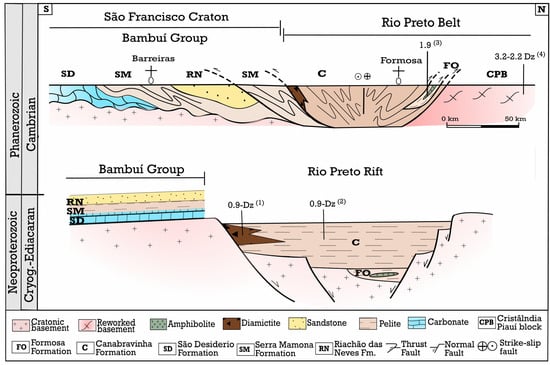
4. The Rio Preto Fold Belt
The Rio Preto belt occurs on the northwest limit of the SF Craton and is located in the northwest of Bahia and south of Piauí [1,89,90,91,92,93]. The Rio Preto belt is formed by the basement (archean–Paleoproterozoic migmatites and granitoids), Formosa Formation (mica schists, quartzites, greenschists. and amphibolites) of Paleoproterozoic age (~1.9 Ga) and by the Canabravinha Formation (metadiamictites, quartzites, and mica schist) of Neoproterozoic age (850–600 Ma). The basement occurs locally to the southeast, close to the city of Barreiras-BA, and to the north, where it receives the name of Cristalândia do Piauí Complex (Figure 4).
The Formosa Formation crops out in the northern portion of the belt, extending for ca. 20 km toward the north, reaching the region of the boundary between the states of Bahia and Piauí. It is composed of garnet-muscovite schists with layers of micaceous quartzites, metarhythmites, iron-manganese metacherts, chlorite-actinolite-epidote schist (greenschist), and, locally, ortho-amphibolite intercalations. The latter is particularly well exposed at the Angico farm, to the west of Formosa do Rio Preto town, where a 200 m thick ortho-amphibolite layer is concordantly intercalated with metasedimentary rocks. These amphibolites were interpreted as tholeiitic gabbros metamorphosed under epidote-amphibolite facies conditions (around 500 °C and 2–5 kbar), and U-Pb analyses of magmatic zircon crystals yielded a precise age of 1958.3 ± 16 Ma [94]. Thus, the Formosa Formation represents a paleoproterozoic basement of the Rio Preto belt (see Figure 4).
The Canabravinha Formation occurs in the southern portion of the Rio Preto belt, extending from the village of Cariparé toward the north for almost 40 km. It also occurs in the direction of the northern Paramirim Corridor, with an extension of 200 km to the northeast. It is composed of immature quartzites and metawackes, metapelites (locally carbonaceous), metarhythmites, metadiamictites with pebbles and cobbles, and, locally, metamarl. The quartzites and metawackes show lithic, feldspathic, carbonate-rich, and micaceous varieties. Conglomeratic quartzites show plane-parallel structures and graded bedding, suggesting sedimentation by turbidite currents. The vertical and lateral facies changes observed in the Canabravinha Formation characterize a transition from coarse-grained rocks on the south (metadiamictite and metawackes) to medium- and fine-grained facies on the north (metarhythmites and phyllites). The deposition of the Canabravinha Formation was interpreted as occurring in a submarine gravel-rich slope–apron environment with gravitational sedimentation [95]. The spectrum of U-Pb ages of the detrital zircons of the Canabravinha Formation differs from the Formosa Formation, spreading from 3000 to 900 Ma [95]. The Nd isotopes also indicate a larger variety of sources, with TDM model ages between 1.5 and 2.7 Ga. The Canabravinha Formation was deposited into Neoproterozoic asymmetrical rift basin (hemi-graben basin) with gravitational flows and turbiditic sediments (Figure 4).
The Bambuí Group that outcrops on the São Francisco craton near the Rio Preto fold belt margin, was subdivided in western Bahia state into three formations [89,96], from the base to top (Figure 4): the São Desidério (dark gray limestones with intercalations of siltstones, correlated with Lagoa Jacaré Formation); Serra da Mamona (metasiltstones and slates, correlated with Serra da Saudade Formation); and Riachão das Neves Formation (meta-arkoses, metasiltstonesand metagraywackes correlated with Três Marias Formation).

Figure 4. The Rio Preto Belt: sedimentary basin, extensional and contractional events, and geological evolution [89,92,93]. Geochronological data: 1—[95]; 2—[99]; 3—[94]; 4—[97]. Dz: Detrital zircon.
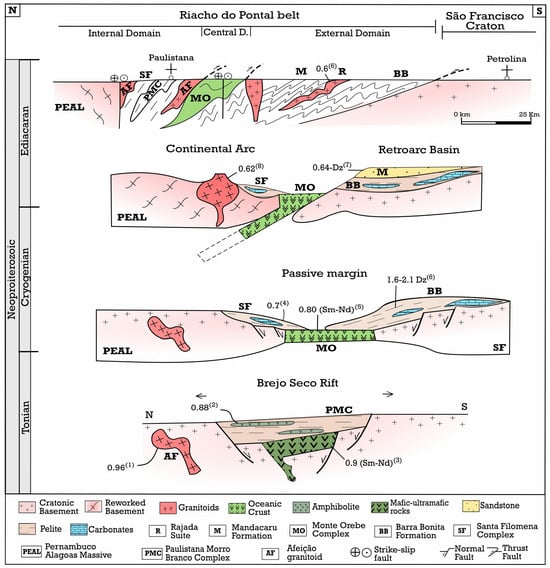
5. The Riacho Do Pontal Orogen
At the northern limit of the São Francisco craton, the Riacho do Pontal belt occurs between the states of Bahia, Pernambuco, and Piauí [1,100,101]. It is a hot and dry region of northeastern Brazil.
Many different data suggest the division of the Riacho do Pontal Orogen into three tectonostratigraphic zones: external, central, and internal [92,100,101,102,103]. To the north, it is bounded by the E-W trending dextral strike-slip western branch of the Pernambuco shear zone. The basement is represented by TTG-orthogneisses from the Gavião/Sobradinho block of the São Francisco craton [92] and crops out in the Sobradinho dam area. Tectonic scales of basement rocks (banded migmatitic gneisses) occur locally within the fold belt.
In its internal zone, the Riacho do Pontal Belt comprises highly reworked Archean/Paleoproterozoic migmatitic basement slices and volcano–sedimentary sequences such as the Paulistana, Santa Filomena, and Morro Branco complexes. These are also intruded by large quantities of igneous rocks, which include both the Brejo Seco and Sao Francisco de Assis mafic–ultramafic complexes [92,103,104] and the Afeição Suite augen-gneiss [105,106]. The units have undergone amphibolite facies metamorphism and intense deformation due to thrust and strike-slip shear zones. The central zone of the Riacho do Pontal belt shows a complex synformal structure trending EW and featuring ophiolitic rocks from the Monte Orebe Complex. The Riacho do Pontal belt’s southernmost outer zone exhibits a south-trending nappe system consisting of Casa Nova Group supracrustal rocks metamorphosed under greenschist facies (Barra Bonita and Mandacaru Formations).
A comprehensive examination of the plutonic rocks found in the Afeição Suite was conducted, indicating their association with the Tonian Cariris Velhos magmatic arc of the Borborema Province [106]. The Afeição Suite is primarily composed of high-silica ferroan and magnesian granites–granodiorites that are calc-alkaline, high-K, and peraluminous. Additionally, the chondrite normalized REE patterns are moderately to highly fractionated with a negative Eu anomaly. Incompatible elements exhibit a negative Nb-Ta anomaly, which is reminiscent of convergence setting granites. Zircon U-Pb data providing a crystallization age between 1000 and 960 Ma confirm a correlation with the Cariris Velhos belt [106]. Support for this correlation is provided by εNd(t) values between −1.0 and +3.1 and TDM model ages of 1.2–1.5 Ga [106,107,108]. The Afeição suite rocks are remnants of the roots of Tonian magmatic arcs, which were intruded into the basement of the Riacho do Pontal orogen.
The Paulistana Complex consists of garnet-mica schists and muscovite quartzites, with intercalations of greenschists (metabasalts), amphibolites (metagabbros), and ultramafic lenses [103]. The Paulistana Complex metasedimentary rocks are oriented NE-SW and dip northwesternward at angles ranging from 20° to 60°. These lithotypes often intercalate with metagabbros, garnet–amphibolites, metapyroxenites, tremolite–actinolite schists, and metacherts [92]. Zircon crystals extracted from a metagabbro indicate a Concordia age of 882.8 ± 4 Ma [101]. Additionally, based on detrital zircon data, the maximum depositional is calculated at 900 Ma [109,110]. The Paulistana Complex may be interpreted as a constituent of a continental rift setting [101], as shown in Figure 5.

Figure 5. The Riacho do Pontal Belt: sedimentary basins, extensional and contractional events, and geological evolution [92,93,101,109]. Geochronological data: 1—[106]; 2—[101]; 3—[104]; 4—[109,110]; 5—[112]; 6—[101]; 7—[101,109]; 8—[118]. Dz: Detrital zircon.
The Brejo Seco Complex is a tectonically interleaved intrusion within the Morro Branco volcanosedimentary sequence, approximately 10 km in length. The complex stratigraphy can be classified into four major zones [104]: Lower Mafic Zone (LMZ), Ultramafic Zone (UZ), Mafic Transitional Zone (MTZ), and Upper Mafic Zone (UMZ). The Brejo Seco complex consists of a thin basal mafic unit (metagabbros and troctolites), succeeded by serpentinized dunite, layered troctolite–gabbro, leucogabbro, minor anorthosite, ilmenite gabbro and ilmenite–magnetitite [92,104]. The entire complex, with a maximum thickness of 3 km, is characterized by tectonic inversion. The ultramafic units are located in the northern portion of the region and overlay the mafic units to the south. The northern and southern contacts are marked by EW-trending reverse shear zones. The Brejo Seco Complex is a typical layered intrusion of mafic–ultramafic rocks that was formed approximately 900–850 million years ago in a continental rift environment [101,104]. The Tonian Brejo Seco rift shares similarities with the Cryogenian Canindé rift located in the adjacent Sergipano fold belt (see below). The Brejo Seco Complex is interpreted as intruded in a continental extension setting, probably related to the emplacement of a mantle plume [104] (see Figure 5).
The Santa Filomena Complex is located in the northeastern region, situated between the Pernambuco lineament in the north and the Monte Orebe Complex in the south. The complex consists of quartzites, muscovite, biotite, garnet, kyanite, staurolite, cordierite, and sillimanite schists, with occasional local calcitic marble and minor metamafic intercalations. It outcrops in the internal portion, toward the north of the orogen and exhibits metamorphism in the amphibolite facies and intense deformation. Peak metamorphic conditions are estimated to be around 640 °C and 12 kbar [110]. The predominance of ages around 800–750 Ma from detrital zircon populations of the Santa Filomena Complex [109,110] suggests that it has a Tonian–Cryogenian age. The Santa Filomena Complex was probably a passive margin over the Pernambuco-Alagoas massif (PEAL) and can be correlated with the Barra Bonita Formation. Thus, extensional efforts continued to dominate the region during the late Tonian and early Cryogenian, resulting in the evolution of a rift into a passive continental margin located to the north of the São Francisco paleocontinent (Figure 5).
The Riacho do Pontal belt’s central zone exhibits a 100 km long, east–west trending synformal structure recognized as the Monte Orebe synform [103,111]. The geology of the area is complex, with both south-verging thrusts and E-W strike-slip shear zone systems. The central zone is dominated by the Monte Orebe Complex, consisting of basic metavolcanics (actinolite schists, ortho-amphibolites, and metatuffs) interlayered with deep-sea pelagic metasedimentary rocks, particularly metachert (sometimes iron-rich) and garnet–mica schist, as well as local occurrences of metagreywacke and quartz-schist [92,103]. There is a predominance of hornblende–amphibolites, metabasalts with preserved primary texture indicating submarine eruptions, actinolite–tremolite schists, metachert layers, quartzites, phyllites, graphite schists, and tuffs. The Monte Orebe Complex protoliths have a tholeiitic, MORB-type affinity [112,113]. Sm-Nd isotopic data yield a whole rock isochron age of 819 ± 120 Ma with an initial εNd(t) = +4.4, suggesting a depleted mantle source [113]. The Monte Orebe Complex is interpreted as being composed of remnants of a Neoproterozoic ophiolite sequence of about 820 Ma, which marks the development of new oceanic crust and separates the Borborema province (PEAL block) from the São Francisco paleocontinent to the south [113].
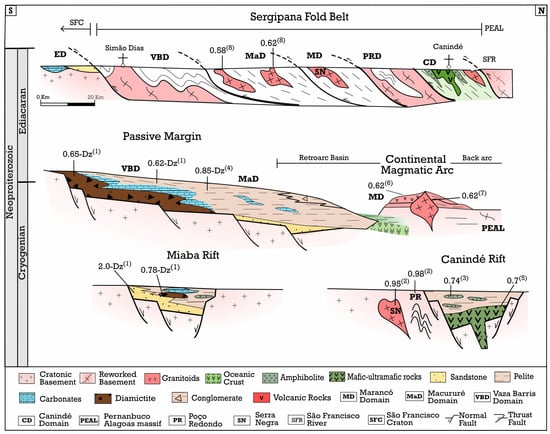
6. The Sergipano Orogen
The Sergipano belt is a Brasiliano/Pan-African fold-and-thrust belt located on the northeastern edge of the São Francisco craton in the states of Bahia, Sergipe, and Alagoas [1,100,120,121,122,123,124]. It was formed by a continental collision between the São Francisco-Congo Paleocontinent and the Pernambuco Alagoas Massif (PEAL) during the Brasiliano/Pan-African orogeny [100,120,121,122,123,124,125,126,127]. The basement of the São Francisco craton, to the south of the Sergipano belt, is a granite–greenstone belt sequence with archean–paleoproterozoic high-grade terranes. The Pernambuco-Alagoas massif (PEAL), to the north of Sergipano belt, comprises Archean–Palaeoproterozoic high-grade gneisses and migmatites, early Neoproterozoic rocks (Cariris Velhos), and Neoproterozoic volcano–sedimentary supracrustal belts intruded by Neoproterozoic granitoids [100,128,129].
The Sergipano belt is divided from north to south into the Canindé, Poço Redondo, Marancó, Macururé, Vaza Barris, and Estância tectonostratigraphic domains, limited by important contractional shear zones [120,122,124,125,130]. The northern Canindé, Poço Redondo, Marancó, and Macururé domains show amphibolite metamorphic facies. Toward the south, the Vaza Barris domain has greenschist facies, and the cratonic Estância domain presents unmetamorphosed rocks.
Some researchers performed stratigraphic studies on the Vaza Barris domain and divided the supracrustal sequences into two groups, the Miaba and Vaza Barris groups [131], later modified by [121,132]. The Macururé domain consists mainly of garnet micaschist, phyllite, and metarythmithe, with some quartzite and marble [130]. These metasedimentary rocks were intruded by granitic plutons dated at about 625–630 Ma [133,134]. The Marancó domain is mainly formed by a metavolcanosedimentary sequence with 603 Ma, with dacites-andesites and granodiorite stocks dated at 595 ± 11 Ma [135,136], suggesting an Ediacaran continental arc.
Tonian–Cryogenian extensional tectonics (800–640 Ma) occurred on the stretched, rifted margin of Archean–Paleoproterozoic basement, giving rise to (1) the 0.95 Ga Serra Negra A-type crustal melt granites; (2) the Canindé rift (715–640 Ma) formed between the Pernambuco-Alagoas block (PEAL) and the Poço Redondo/Marancó domain; and (3) the Miaba rift in the south on the stretched São Francisco paleocontinent (see Figure 6).
The Cryogenian Canindé rift shows a bimodal association of A-type granites (715 Ma) and volcano–sedimentary Novo Gosto-Mulungu-Gentileza units [132,137] made up of fine-grained amphibolites intercalated with metapelites, metacherts, graphite schists, calc-silicate rocks and marbles, crosscut by mafic and felsic dykes, an elongated pink granite sheet (Garrote unit) and gabbros. LA-ICP-MS U–Pb zircon dating of one amphibolite sample from the Novo Gosto unit resulted in an age of 743 ± 3 Ma [126]. The Canindé gabbroic complex (NW-trending, 40 km long, 3–5 km wide) comprises three main rock groups: (1) leucogabbros and troctolites; (2) Fe-Ti oxide gabbros; and (3) mafic–ultramafic cumulates: norites, pyroxenites, and hornblendites. Diorites (688 Ma) and rapakivi granites (684 and 641 Ma) also occur. The Canindé gabbroic complex is interpreted as a continental-type layered intrusion in an extensional intracontinental rift basin [124,125,137,139].
The Miaba rift consists of the Itabaiana Formation (quartzites), the Ribeirópolis or Jacarecica Formation (phyllites), and the Jacoca Formation (metacarbonates), with 200–1000 m thick [120,121,140,141]. The Itabaiana Formation rests unconformably on basement gneisses and migmatites of the Itabaiana and Simão Dias domes in the southern belt. The unit comprises a basal level of poorly sorted feldspathic metasandstones with cross-bedding stratification and metaconglomerates deposited in alluvial and fluvial environments that pass gradually up section into well-sorted sandstones deposited in the shallow marine environment. It is overlain by phyllite and metadiamictite with pebbles of gneiss and quartzite and intercalations of metagreywacke and metavolcanics (Ribeirópolis Fm., 300 m thick).
Stratigraphically, the Vaza-Barris Group is divided into Capitão Palestina Formation (metadiamictite, metasiltite, metagreywacke, 100–2000 m thick) succeeded by grey to black limestone and dolomite, occasionally with phyllite intercalations (Olhos D’Água Formation, 200–1000 m thick) and phyllite, metagreywacke of Frei Paulo Formation, with 1000–1500 m thick [120,131,132,141,143]. The metadiamictites of the Capitão Palestina formation are interpreted as subaqueous debris flows adjacent to normal faults and glacially influenced deposits [44,141,143] and have clasts lithotypes composed of granite-gneiss, sandstone, carbonate, and schist. The lateral variation in lithofacies and thicknesses is interpreted as sedimentary infilling under a syn-depositional extensional regime with sedimentation tectonically controlled by the basement domes (horst) and normal faults [140]. The youngest detrital zircon grains from the Capitão Palestina Formation are 653 Ma, and from the Frei Paulo are 620 Ma [123,124,142]. From carbon and oxygen isotopes of the Olhos d’Água and Jacoca formations and the diamictites and conglomerates below them, both Sturtian (720–660 Ma) and Marinoan (650–635 Ma) glacial epochs can be recognized in the Sergipano belt [143]. The geochronological data suggest that the deposition of the Jacoca Formation carbonates is younger than 780 Ma in the Miaba rift and that the deposition of the Olhos D’Agua Formation probably took place between 650 and 620 Ma into the rift to passive margin basin [44,124,125,141,143].
The Macururé domain shows metarythmithe, sometimes with graded beds, interpreted as metaturbidites, feldspathic-aluminous mica schists with minor intercalations of quartzite, marble, and metavolcanic rocks, lenses up to 200 m in length of amphibolite, garnet amphibolite, and chlorite schist [124,130]. Together with the Vaza Barris Group, it probably comprises a submarine fan depositional environment in a passive margin setting, with sedimentation by gravitational flows. There is a predominance of cohesive and noncohesive debris flow to the south (diamictites of the Vaza Barris Group) and a predominance of dilute turbidity currents to the north (turbidites of the Macururé Group [130,141]). Detrital zircon ages of quartzite and mica schist in the Macururé domain indicate dominantly Paleoproterozoic, Mesoproterozoic, and early Neoproterozoic, suggesting that the basement was the main provenance of the Macururé sediments. No zircons younger than 856 Ma were found [124,142,144]. The sedimentation age of the Macururé Group ranges from ca. 850 Ma (younger detrital zircon grains) to the age of the intrusive granites–granodiorites—630 Ma [124,132,134]. The Vaza Barris and Macururé domains are interpreted as a rift to the passive margin basin of the Sergipano belt, although some occurrences, such as the Graccho Cardoso meta-conglomerate [124], suggest the involvement of a retroarc basin (see Figure 6).

Figure 6. The Sergipano Belt: sedimentary basins, extensional and contractional events, and geological evolution [124,125,142]. Geochronological data: 1—[124,142]; 2—[124,135]; 3—[126]; 4—[142]; 5—[124,137,138]; 6—[124,134,135]; 7—[145]; 8—[133,134]. Dz: Detrital zircon.
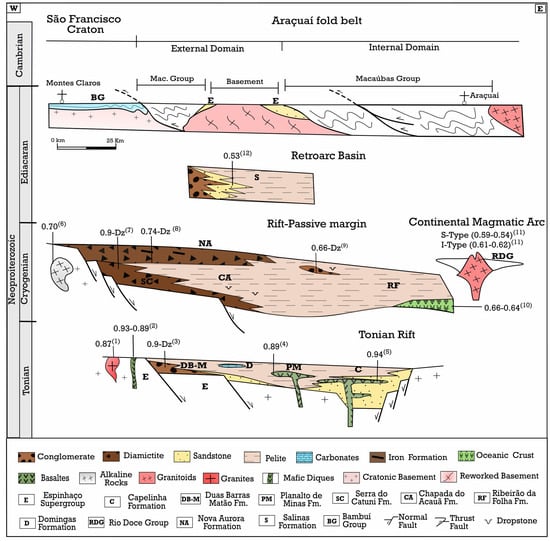
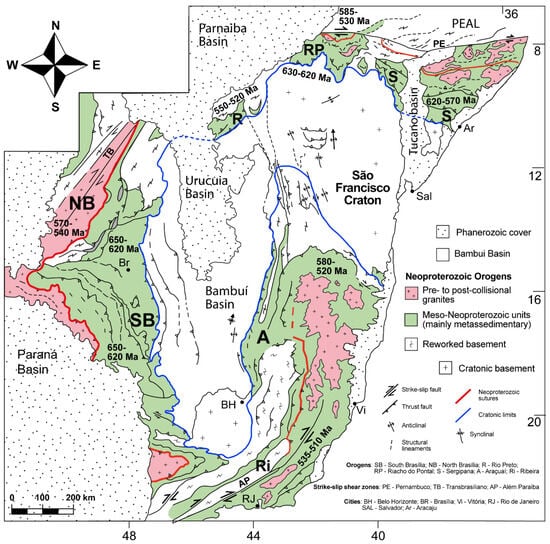
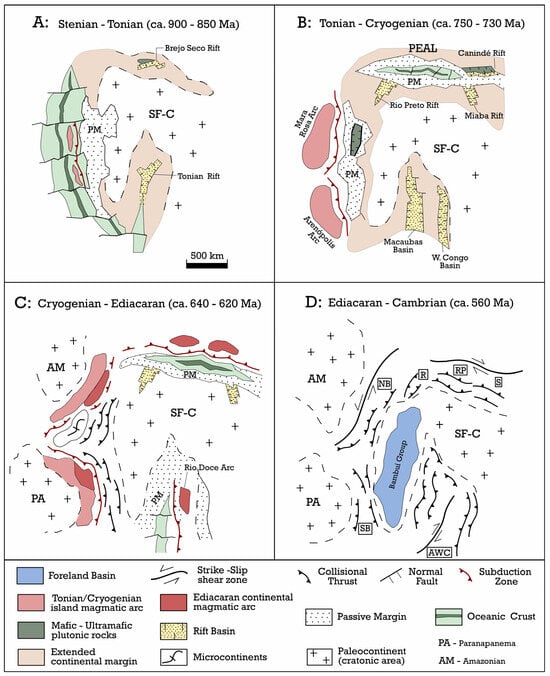
7. The Araçuaí Orogen
The Araçuaí Belt occurs at the curved southeastern margin of the São Francisco craton, showing a transition to the south with the Ribeira belt. The Araçuaí Belt consists of basement (units older than 1.8 Ga and rift–sag basin of the Espinhaço Supergroup), a Tonian rift, the Cryogenian rift–passive margin Macaúbas Group, as well as the syn-orogenic Salinas Formation and the high grade metamorphic–granitic core complex, the Jequitinhonha and Nova Venécia Complexes [146,147,148,149,150,151] (Figure 7).
The Paleo-Mesoproterozoic Espinhaço Supergroup is composed of ca. 5000 m-thick succession of quartz-rich sandstones, pelites, conglomerates, and volcanic rocks accumulated in an intracontinental basin (rift to rift–sag), with low-grade metamorphism [152,153,154,155]. The Neoproterozoic Macaúbas Group represents an extensive, and up to 10 km = thick sedimentary succession metamorphosed under greenschist to amphibolite facies, which crops out along most of the northern Araçuaí belt.
The oldest basin-forming episode recorded by the Macaúbas Group is represented by a Tonian rift between ca. 900 Ma and 850 Ma [151,156,157,158]. The onset of this event is marked by bimodal magmatism, which comprises (1) the Formiga-Pedro Lessa mafic dykes—930 to 895 Ma [159,160,161] and (2) the A-type granites of the Salto da Divisa Suite—ca. 875 Ma [162,163]. It occurs as intrusions into the basement and into the Espinhaço Supergroup.
The Tonian rift is about 250 km long in the NE-SW direction and 150 km wide, almost always covered by the middle–upper units of the Macaúbas Group. The Tonian rift is filled by continental to shallow marine sedimentary rocks of the Matão, Duas Barras, Domingas, Capelinha, and Rio Peixe Bravo formations [156,164,165,166]. U-Pb detrital zircon age determinations on these units indicate Archean to Neoproterozoic sources and a maximum depositional age compatible with the rift-related magmatism [157,158,165]. The Matão and Duas Barras Formations comprise 100–200 m thick, alluvial, and fluvial breccias, conglomerates, and sandstones with cross-bedding and paleocurrents toward NE and NW [156,164]. Detrital zircon ages set a maximum depositional age for the Duas Barras Formation at 900 ± 21 Ma [157]. To the top, there are pelites and stromatolitic carbonate lenses (Domingas Formation) deposited in shallow marine conditions during a transgressive episode [164].
The Serra do Catuni Formation from the Macaúbas Group comprises massive diamictite with local sandstone and pelite intercalations. Distinctive glacial sedimentary features include dropstones in metarythmithes, boulders, and striated flat-iron-shaped clasts [168]. The youngest detrital zircon grains constrain the maximum depositional age at 933 ± 8 Ma [157]. Although dubious, the Serra do Catuni Formation may be related to the Sturtian glaciation (ca. 720–660 Ma).
The Chapada Acauã Formation from the Macaúbas Group consists of massive and graded sandstones and pelites, composing a cyclic succession of sandy to muddy turbidites with local diamictite intercalations. Detrital zircon grains from a quartzite of the Upper Chapada Acauã Formation suggest a maximum depositional age of around 864 ± 30 Ma [147] and 743 ± 7 Ma [158].

Figure 7. The Araçuaí Belt: sedimentary basins, extensional and contractional events, and geological evolution [147,149,150,151,184]. Geochronological data: 1—[162]; 2—[159,160,161]; 3—[156,157,158]; 4—[166]; 5—[165]; 6—[167]; 7—[157]; 8—[158]; 9—[171,172]; 10—[173,174,176]; 11—[181,182,183,184]; 12—[45,150,179]. Dz: Detrital zircon.
8. Summary
The São Francisco craton is surrounded by several Neoproterozoic orogens and fold belts. Geochronological data of deformation and metamorphism provide constraints for the sequence of collision events that led to the formation of the West Gondwana supercontinent. The assembly was diachronous and occurred in important three-stage Neoproterozoic–Cambrian collision processes (Figure 8).
The Southern Brasília belt (Figure 2) presents the development of the Tonian Araxá-Canastra-Vazante passive margin and Tonian–Cryogenian intraoceanic magmatic arcs with arc-related sedimentary basins [38,50,190]. Progressively, the intraoceanic scenario evolves to an arc–continent collision in Cryogenian time. During the late Cryogenian, a retroarc basin (Araxá and Ibiá Groups) occurs, with gravitational sedimentation within a deep submarine fan, which transitions to the gravitational and glacial sedimentation of the Vazante Group (Santo Antônio do Bonito and Rocinha Formations) and Jequitaí Formation to the east, toward the São Francisco paleocontinent [24,31,43]. Thus, the Southern Brasília Belt shows different basin settings overlapping in time: Tonian passive margin and arc-related basins to Cryogenian–Ediacaran retroarc foreland basin (Ibiá Group) and Ediacaran-Cambrian peripheral foreland basin (Bambuí Group).

Figure 8. Simplified tectonic map of the central–eastern region of Brazil with an indication of the three collisional diachronic events in the formation of the SF Craton: Brasília Belt (collision I: 650–620 Ma), Riacho do Pontal–Sergipano Belt (collision II: 620–570 Ma) and Araçuaí Belt (collision III: 580–520 Ma) (see text). Modified from [9,192].
The Northern Brasília belt (Figure 3) is an east- to southeast-verging fold–thrust belt that involves Archean basement, Paleo-Mesoproterozoic rift (Araí Group) and rift-sag basins (Serra da Mesa and Traíras Groups), a Stenian passive margin (Paranoá Group) with the Juscelândia, Indaianópolis and Palmeirópolis volcanosedimentary sequences. During the Ectasian-Stenian, the Paranoá passive margin develops, strongly asymmetrical, associated with an important extensional phase, filled by sandstones, pelites, rhythmites, and carbonates lenses with columnar stromatolites, arranged in transgressive and regressive cycles [14,70,72]. The Stenian passive margin is related to the deposition of the Paranoá Group sediments and probably the volcano–sedimentary sequences that show ocean floor basalts (MORB) [14,75].
To the north of the São Francisco craton, the Rio Preto, Riacho do Pontal, and the Sergipano belts are separated from each other by basement highs. The Rio Preto belt shows the Canabravinha Formation was deposited into an asymmetrical rift basin (hemi-graben basin) with gravitational flows and turbiditic sediments (Figure 4). The belt is interpreted as an intracontinental rift at the termination of the Riacho do Pontal and Sergipano orogens. Neoproterozoic–Cambrian deformation, between 550 and 520 Ma, originated a complex, asymmetrical, and double-verging thrust wedge associated with the northwest curvature of the SFC [93]. The Riacho do Pontal and Sergipano belts (Figure 5 and Figure 6) contain south-verging thrusts involving basement rocks older than 1.8 Ga, Tonian and Cryogenian rift-related units (Brejo Seco, Miaba and Canindé rifts), Cryogenian passive margin assemblages (Casa Nova Group, Monte Orebe ophiolitic rocks, Vaza Barris and Macururé Groups) and Ediacaran continental magmatic arcs [93,100,101,109,124,125].
The Araçuaí belt (Figure 7) that fringes the southeastern São Francisco craton contains west-verging thrusts and folds. In the Araçuaí belt, there are Neoproterozoic rocks of the Macaúbas Group, forming the intracontinental Tonian rift and the Cryogenian–Ediacaran passive margin of Serra do Catuni, Chapada Acauã, Nova Aurora, and Ribeirão da Folha formations. Furthermore, there is the Ediacaran continental arc Rio Doce Group and the forearc Salinas basin [45,147,150,151]. The Macaúbas basin is dominantly a large continental rift with steep N-S and NW-SE normal fault edges. To the southeast, due to differential extension, the basin evolved as a localized passive margin with oceanic crust. The crustal extension was accommodated by E-W transfer faults. Reactivations at the edges of the Macaúbas rift gave rise to thick gravitational sedimentation, with cohesive debris flow (diamictites) and turbidity currents (sandstones and pelites) and glacial influence [169,171,172], during the early and late Cryogenian. These units of the Macaúbas Group, exposed along the belt, were metamorphosed under greenschist to amphibolite facies conditions and were affected by thrusts, reverse faults, and craton-ward verging folds, developed between 575 and 530 Ma [149,151]. The Araçuaí orogenic front propagates into the craton interior and interacts with preexistent rift structures, affecting rocks within the Paramirim corridor. To the southern, the Ribeira belt was deformed between 610 and 560 Ma [9,18,194], with the docking of the Cabo Frio terrane at 535–510 Ma [195]. The northern Ribeira belt is characterized by a 500 km long network of anastomosing transcurrent shear zones parallel to the belt. A northeast–trending dextral transpressive belt is interpreted as a later oblique convergence between the São Francisco Craton and Congo Craton [196]. NE-trending, dextral strike-slip shear zones with late collisional leucogranites, pegmatites, and hydrothermal fluids are dated at 535–510 Ma [194]. The Araçuaí orogen is related to a third collisional event in central-east Brazil, between São Francisco and Congo cratons at 580–530 Ma (Figure 8).
Paleogeographic maps are presented at the end (Figure 9), illustrating the diachronic evolution of Neoproterozoic orogens around the São Francisco-Congo (SF-C) paleocontinent. A large Tonian–Cryogenian ocean occurred to the west, with amalgamated intraoceanic magmatic arcs (Brasília belt). To the north (Riacho do Pontal-Sergipano belt) and south (Araçuaí belt), small v-shaped oceans with hyperextended margins occurred, with Ediacaran continental magmatic arcs [197].

Figure 9. Simplified paleogeographic maps illustrating the diachronic evolution of the orogens around the São Francisco–Congo (SF-C) paleocontinent during the Neoproterozoic. Explanations for each subfigure are given in the Discussion chapter.
This entry is adapted from the peer-reviewed paper 10.3390/min14010043
This entry is offline, you can click here to edit this entry!
